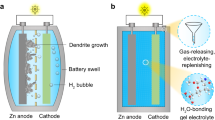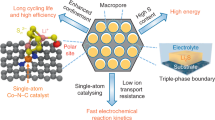Abstract
All-solid-state zinc–air pouch cells promise high energy-to-cost ratios with inherent safety; however, finding earth-abundant high power/energy cathodes and super-ionic electrolytes remains a fundamental challenge. Here we present realistic zinc–air pouch cells designed by the (101)-facet copper phosphosulfide [CPS(101)] as a cathode as well as anti-freezing chitosan-biocellulosics as super-ionic conductor electrolytes. The proposed CPS(101) exhibits trifunctional activity and stability (>30,000 cycles) towards reversible oxygen reactions and hydrogen evolution reactions, outperforming commercial Pt/C and RuO2. Furthermore, hydroxide super-ion conductors utilizing polymerized chitosan-biocellulosics reveal exceptional conductivity (86.7 mS cm−1 at 25 °C) with high mechanical/chemical robustness. High cell-level energy densities of 460 Wh kgcell–1/1,389 Wh l−1 are normally measured in pouch cells (1 Ah) with a cycle lifespan of 6,000/1,100 cycles at 25 mA cm−2 for 20/70% depths of discharge, and the highest densities we could achieve were 523 Wh kgcell–1/1,609 Wh l−1. Flexible pouch cells operate well at rates of 5–200 mA cm−2 over a broad temperature range of −20 to 80 °C.
This is a preview of subscription content, access via your institution
Access options
Access Nature and 54 other Nature Portfolio journals
Get Nature+, our best-value online-access subscription
$29.99 / 30 days
cancel any time
Subscribe to this journal
Receive 12 digital issues and online access to articles
$119.00 per year
only $9.92 per issue
Buy this article
- Purchase on Springer Link
- Instant access to full article PDF
Prices may be subject to local taxes which are calculated during checkout







Similar content being viewed by others
Data availability
The data supporting the findings of this study are available within the article and its Supplementary Information. Source data are provided with this paper.
References
Davis, V. et al. Room-temperature cycling of metal fluoride electrodes: liquid electrolytes for high-energy fluoride ion cells. Science 362, 1144–1148 (2018).
Randau, S. et al. Benchmarking the performance of all-solid-state lithium batteries. Nat. Energy 5, 259–270 (2020).
Liu, J. et al. Pathways for practical high-energy long-cycling lithium metal batteries. Nat. Energy 4, 180–186 (2019).
Liu, Y., Zhu, Y. & Cui, Y. Challenges and opportunities towards fast-charging battery materials. Nat. Energy 4, 540–550 (2019).
Shinde, S. et al. Unveiling dual-linkage 3D hexaiminobenzene metal–organic frameworks towards long lasting advanced reversible Zn–air batteries. Energy Environ. Sci. 12, 727–738 (2019).
Tam, T. et al. Novel graphene hydrogel/B-doped graphene quantum dots composites as trifunctional electrocatalysts for Zn−air batteries and overall water splitting. Adv. Energy Mater. 9, 1900945 (2019).
Kato, Y. et al. High-power all-solid-state batteries using sulfide superionic conductors. Nat. Energy 1, 16030 (2016).
Fu, J. et al. A flexible solid-state electrolyte for wide-scale integration of rechargeable zinc–air batteries. Energy Environ. Sci. 9, 663–670 (2016).
Wang, J. et al. Poly(aryl piperidinium) membranes and ionomers for hydroxide exchange membrane fuel cells. Nat. Energy 4, 392–398 (2019).
Tian, X. et al. Engineering bunched Pt–Ni alloy nanocages for efficient oxygen reduction in practical fuel cells. Science 366, 850–856 (2019).
Luo, M. et al. PdMo bimetallene for oxygen reduction catalysis. Nature 574, 81–85 (2019).
Qin, Q. et al. A tannic acid–derived N-, P-codoped carbon-supported iron-based nanocomposite as an advanced trifunctional electrocatalyst for the overall water splitting cells and zinc–air batteries. Adv. Energy Mater. 9, 1803312 (2019).
Li, H. et al. Colloidal cobalt phosphide nanocrystals as trifunctional electrocatalysts for overall water splitting powered by a zinc–air battery. Adv. Mater. 30, 1705796 (2018).
Yu, P. et al. Co nanoislands rooted on Co–N–C nanosheets as efficient oxygen electrocatalyst for Zn–air batteries. Adv. Mater. 31, 1901666 (2019).
Cheng, W. et al. Lattice-strained metal–organic-framework arrays for bifunctional oxygen electrocatalysis. Nat. Energy 4, 115–122 (2019).
Cabán-Acevedo, M. et al. Efficient hydrogen evolution catalysis using ternary pyrite-type cobalt phosphosulphide. Nat. Mater. 14, 1245–1251 (2015).
Huang, Y. et al. Solid-state rechargeable Zn//NiCo and Zn–air batteries with ultralong lifetime and high capacity: the role of a sodium polyacrylate hydrogel electrolyte. Adv. Energy Mater. 8, 1802288 (2018).
Xue, W. et al. Intercalation-conversion hybrid cathodes enabling Li–S full-cell architectures with jointly superior gravimetric and volumetric energy densities. Nat. Energy 4, 374–382 (2019).
Lee, Y. et al. High-energy long-cycling all-solid-state lithium metal batteries enabled by silver–carbon composite anodes. Nat. Energy 5, 299–308 (2020).
Huang, Q. et al. Cycle stability of conversion-type iron fluoride lithium battery cathode at elevated temperatures in polymer electrolyte composites. Nat. Mater. 18, 1343–1349 (2019).
Liu, J. et al. Heterovalent-doping-enabled efficient dopant luminescence and controllable electronic impurity via a new strategy of preparing ii−vi nanocrystals. Adv. Mater. 27, 2753–2761 (2015).
Grioni, M. et al. Studies of copper valence states with Cu L3 X-ray-absorption spectroscopy. Phys. Rev. B 39, 1541–1545 (1989).
Saha, S. et al. Exploring the bottlenecks of anionic redox in Li-rich layered sulfides. Nat. Energy 4, 977–987 (2019).
Farrell, S. et al. Evolution of local electronic structure in alabandite and niningerite solid solutions [(Mn,Fe)S, (Mg,Mn)S, (Mg,Fe)S] using sulfur K- and L-edge XANES spectroscopy. Am. Mineral. 87, 1321–1332 (2002).
Yin, Z. et al. X-ray-absorption spectroscopic studies of sodium polyphosphate glasses. Phys. Rev. B 51, 742–750 (1995).
Yao, S. et al. From an Fe2P3 complex to FeP nanoparticles as efficient electrocatalysts for water-splitting. Chem. Sci. 9, 8590–8597 (2018).
Chong, L. et al. Ultralow-loading platinum-cobalt fuel cell catalysts derived from imidazolate frameworks. Science 362, 1276–1281 (2018).
Shinde, S. et al. Scalable 3-D carbon nitride sponge as an efficient metal-free bifunctional oxygen electrocatalyst for rechargeable Zn–air batteries. ACS Nano 11, 347–357 (2017).
Yang, Z. et al. Trifunctional self-supporting cobalt-embedded carbon nanotube films for ORR, OER, and HER triggered by solid diffusion from bulk metal. Adv. Mater. 31, 1808043 (2019).
Mu, C. et al. Rational design of spinel cobalt vanadate oxide Co2VO4 for superior electrocatalysis. Adv. Mater. 32, 1907168 (2020).
Liu, D. et al. Atomically dispersed platinum supported on curved carbon supports for efficient electrocatalytic hydrogen evolution. Nat. Energy 4, 512–518 (2019).
Mahmood, J. et al. An efficient and pH-universal ruthenium-based catalyst for the hydrogen evolution reaction. Nat. Nanotechnol. 12, 441–446 (2017).
Jung, E. et al. Atomic-level tuning of Co–N–C catalyst for high-performance electrochemical H2O2 production. Nat. Mater. 19, 436–442 (2020).
Norskov, J. et al. Origin of the overpotential for oxygen reduction at a fuel-cell cathode. J. Phys. Chem. B 108, 17886–17892 (2004).
Tsai, C., Pedersen, F. & Norskov, J. Tuning the MoS2 edge-site activity for hydrogen evolution via support interactions. Nano Lett. 14, 1381–1387 (2014).
Hammer, B. & Norskov, J. Theoretical surface science and catalysis-calculations and concepts. Adv. Catal. 45, 71–129 (2000).
Weng, Z. et al. Active sites of copper-complex catalytic materials for electrochemical carbon dioxide reduction. Nat. Commun. 9, 415 (2018).
Jiang, L. et al. Building aqueous K-ion batteries for energy storage. Nat. Energy 4, 495–503 (2019).
Lindic, M. et al. XPS investigations of TiOySz amorphous thin films used as positive electrode in lithium microbatteries. Solid State Ion 176, 1529–1537 (2005).
Fleet, M. et al. Polarized X-ray absorption spectroscopy and XPS of TiS3: S K- and Ti L-edge XANES and S and Ti 2p XPS. Surf. Sci. 584, 133–145 (2005).
Szilagyi, R. et al. Description of the ground state wave functions of Ni dithiolenes using sulfur K-edge x-ray absorption spectroscopy. J. Am. Chem. Soc. 125, 9158–9169 (2003).
Zhao, Q. et al. Solid-state polymer electrolytes with in-built fast interfacial transport for secondary lithium batteries. Nat. Energy 4, 365–373 (2019).
Kim, J. et al. Nanomat Li–S batteries based on all-fibrous cathode/separator assemblies and reinforced Li metal anodes: towards ultrahigh energy density and flexibility. Energy Environ. Sci. 12, 177–186 (2019).
Hagen, M. et al. Lithium–sulfur cells: the gap between the state‐of‐the‐art and the requirements for high energy battery cells. Adv. Energy Mater. 5, 1401986 (2015).
Ue, M., Sakaushi, K. & Uosaki, K. Basic knowledge in battery research bridging the gap between academia and industry. Mater. Horiz. 7, 1937–1954 (2020).
Fan, X. et al. All-temperature batteries enabled by fluorinated electrolytes with non-polar solvents. Nat. Energy 4, 882–890 (2019).
Wang, J. et al. Improving cyclability of Li metal batteries at elevated temperatures and its origin revealed by cryo-electron microscopy. Nat. Energy 4, 664–670 (2019).
Wan, J. et al. Ultrathin, flexible, solid polymer composite electrolyte enabled with aligned nanoporous host for lithium batteries. Nat. Nanotechnol. 14, 705–711 (2019).
Li, H. et al. An extremely safe and wearable solid-state zinc ion battery based on a hierarchical structured polymer electrolyte. Energy Environ. Sci. 11, 941–951 (2018).
Wang, F. et al. Highly reversible zinc metal anode for aqueous batteries. Nat. Mater. 17, 543–549 (2018).
Kresse, G. & Hafner, J. Ab initio molecular dynamics for open-shell transition metals. Phys. Rev. B 48, 13115–13118 (1993).
Kresse, G. & Furthmuller, J. Efficient iterative schemes for ab initio total-energy calculations using a plane-wave basis set. Phys. Rev. B 54, 11169–11186 (1996).
Wellendorff, J. et al. Density functionals for surface science: exchange-correlation model development with Bayesian error estimation. Phys. Rev. B 85, 235149 (2012).
Blochl, P. Projector augmented-wave method. Phys. Rev. B 50, 17953–17979 (1994).
Acknowledgements
This work was supported by the Creative Materials Discovery Program (grant no. 2018M3D1A1057844) through the National Research Foundation of Korea (NRF) funded by the Ministry of Science and ICT. S.U.L. thanks the Basic Science Research Program through the NRF funded by the Ministry of Science, ICT and Future Planning (grant no. 2018R1A2B6006320).
Author information
Authors and Affiliations
Contributions
S.S.S. and J.-H.L. conceived of and designed the research projects. S.S.S., J.Y.J., and N.K.W. fabricated the materials, designed the pouch cells, and performed electrochemical measurements. C.-H.L. and S.U.L. performed the computational calculations. D.-H.K. and S.-H.K. characterized the materials. S.S.S. and J.-H.L. analysed the data and wrote the manuscript. All authors contributed to the interpretation of the results. J.-H.L. directed the research.
Corresponding authors
Ethics declarations
Competing interests
The Republic of Korea patents related to this work have been filed (KR10-2020-0021252, KR 10-2020-0021253, KR 10-2020-0021894, KR 10-2020-0164652, KR 10-2020-0164653, KR 10-2020-0164654, KR 10-2020-0164655, KR 10-2020-0164656, KR 10-2020-0164657, KR 10-2021-0008626, KR 10-2021-0008627, KR 10-2021-0023680, KR 10-2021-0023682). The PCT patents to the work have also been filed (PCT/KR2021/002214, PCT/KR2021/002215, PCT/KR2021/002216, PCT/KR2021/002217, PCT/KR2021/002218).
Additional information
Peer review information Nature Energy thanks Yuan Chen and the other, anonymous, reviewer(s) for their contribution to the peer review of this work.
Publisher’s note Springer Nature remains neutral with regard to jurisdictional claims in published maps and institutional affiliations.
Supplementary information
Supplementary Information
Supplementary Figs. 1–87, Notes 1–7, Tables 1–14 and Supplementary Methods.
Supplementary Video 1
Smartphone charging.
Supplementary Video 2
LED illumination.
Supplementary Video 3
Smartphone charging under flexible conditions.
Supplementary Video 4
LED illumination under flexible conditions.
Supplementary Video 5
LED illumination at 0 °C temperature.
Supplementary Data
OER CV stability and battery cycling after mechanical tests.
Source data
Source Data Fig. 1
Energy performance, pie chart distribution, and specific energy and power density values comparison.
Source Data Fig. 2
ORR CV cycles.
Source Data Fig. 6
Battery cycling for long-term stability.
Rights and permissions
About this article
Cite this article
Shinde, S.S., Jung, J.Y., Wagh, N.K. et al. Ampere-hour-scale zinc–air pouch cells. Nat Energy 6, 592–604 (2021). https://doi.org/10.1038/s41560-021-00807-8
Received:
Accepted:
Published:
Issue Date:
DOI: https://doi.org/10.1038/s41560-021-00807-8
This article is cited by
-
Reinforcing oxygen electrocatalytic activity via selective dual-phase heterointerface engineering for rechargeable Zn–air batteries
Rare Metals (2024)
-
Production of gas-releasing electrolyte-replenishing Ah-scale zinc metal pouch cells with aqueous gel electrolyte
Nature Communications (2023)
-
Ampere-hour-scale soft-package potassium-ion hybrid capacitors enabling 6-minute fast-charging
Nature Communications (2023)
-
Rational design of carbon-based electrocatalysts for enhancing redox reactions in rechargeable metal batteries
Nano Research (2023)
-
Recent advances in metal-organic frameworks for oxygen evolution reaction electrocatalysts
Science China Chemistry (2023)



